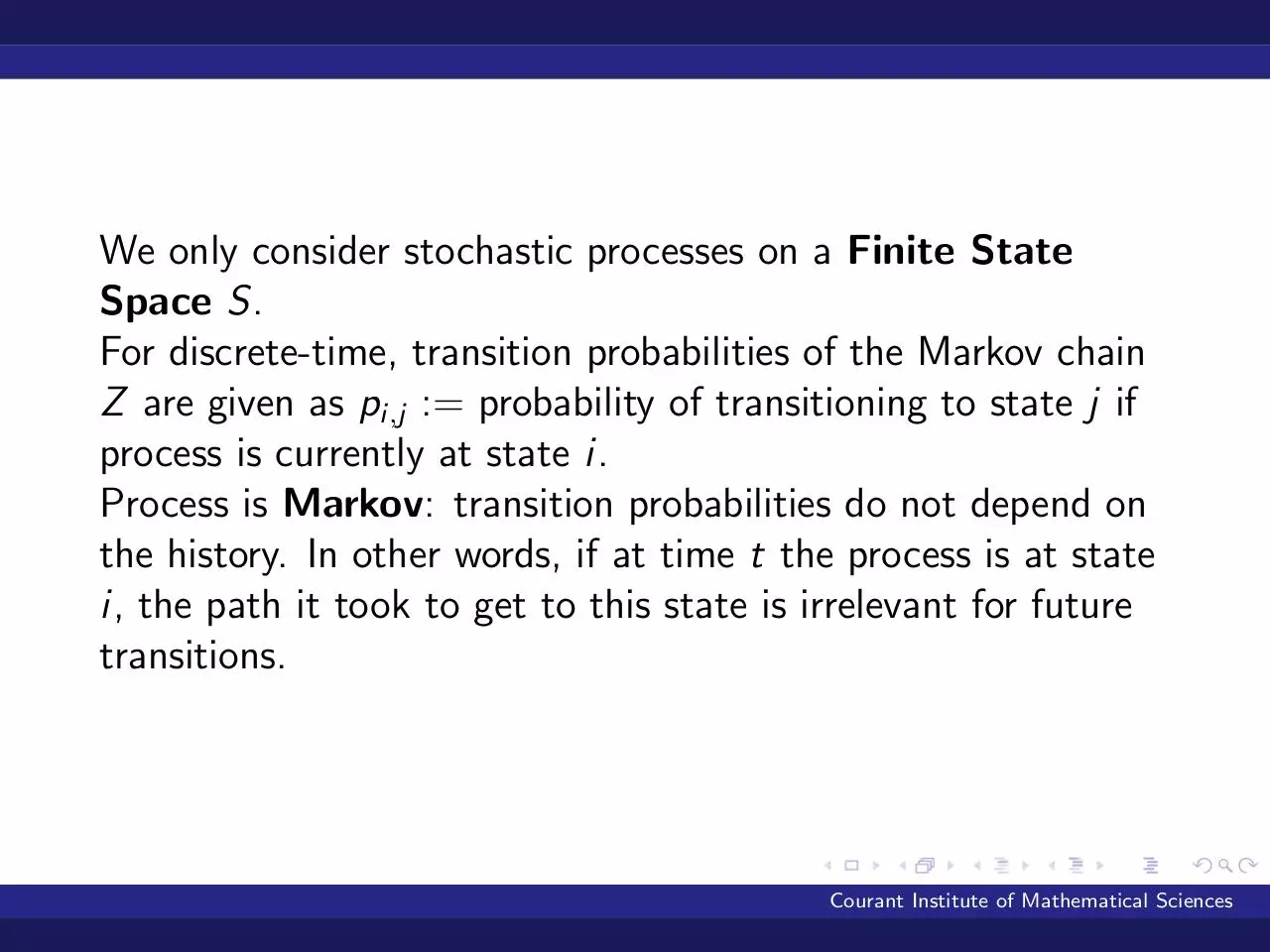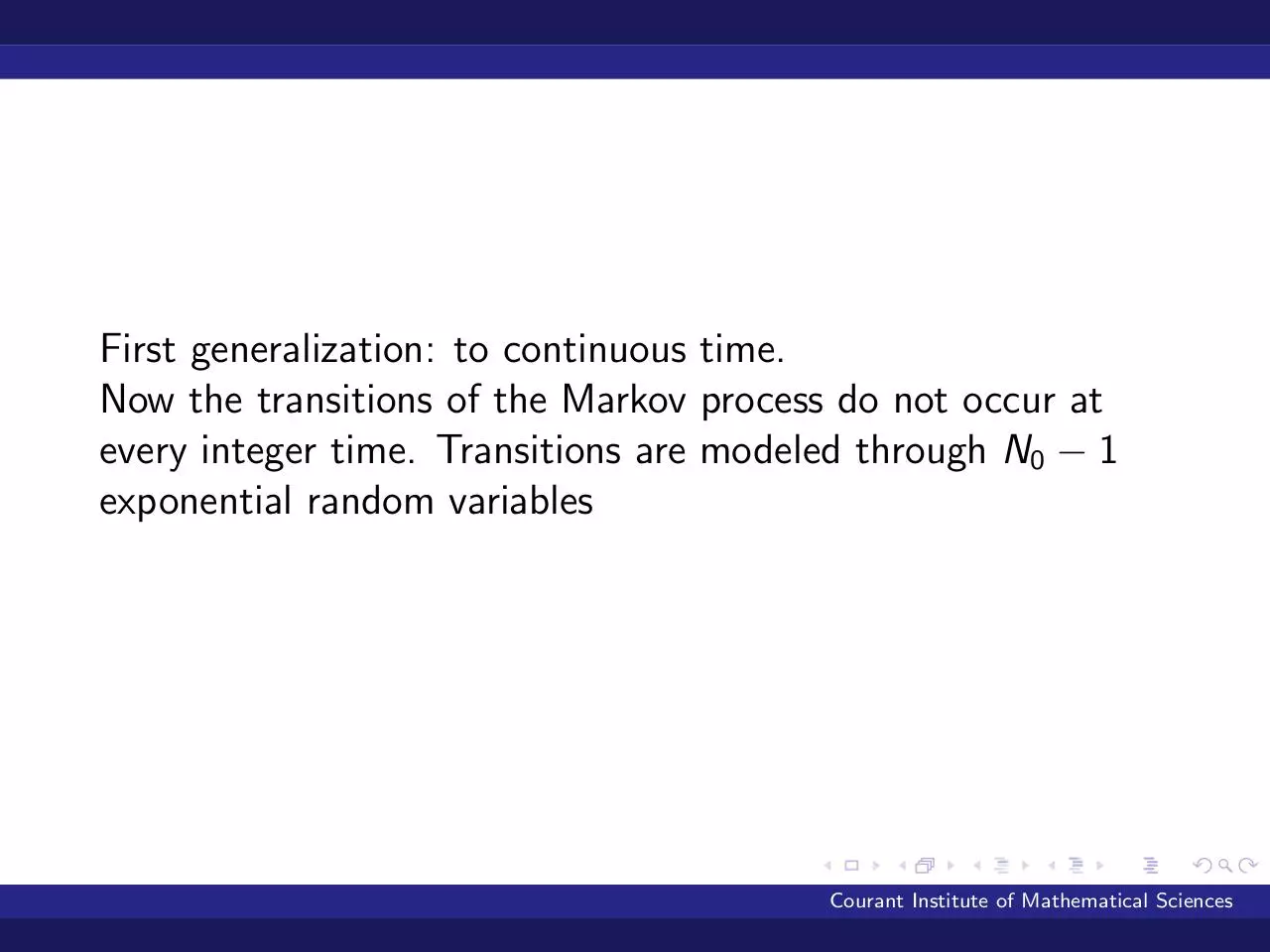SURE Presentation (PDF)
File information
Title: Limit Theorems - for Metastable Markov Chains
Author: Samarth Tiwari, Zsolt Pajor-Gyulai
This PDF 1.5 document has been generated by LaTeX with Beamer class / pdfTeX-1.40.18, and has been sent on pdf-archive.com on 27/10/2017 at 07:17, from IP address 69.202.x.x.
The current document download page has been viewed 349 times.
File size: 249.8 KB (24 pages).
Privacy: public file





File preview
Limit Theorems
for Metastable Markov Chains
Samarth Tiwari, Zsolt Pajor-Gyulai
Courant Institute of Mathematical Sciences
27 October, 2017
Courant Institute of Mathematical Sciences
Formulation of the Problem
What is a discrete-time Markov Chain?
What is a continuous-time Markov Process?
What is a continuous-time semi-Markov Process?
How do we analyze families of stochastic processes?
How is their behavior dependent on time-scales?
Courant Institute of Mathematical Sciences
We only consider stochastic processes on a Finite State
Space S.
For discrete-time, transition probabilities of the Markov chain
Z are given as pi,j := probability of transitioning to state j if
process is currently at state i.
Process is Markov: transition probabilities do not depend on
the history. In other words, if at time t the process is at state
i, the path it took to get to this state is irrelevant for future
transitions.
Courant Institute of Mathematical Sciences
Well known result: for every state i ∈ S, ∃µi : S → [0, 1] such
that
lim P(Z (n) = j Z (0) = i) = µi (j)
n→∞
This µi is the Ergodic measure of Z starting at i.
Courant Institute of Mathematical Sciences
First generalization: to continuous time.
Now the transitions of the Markov process do not occur at
every integer time. Transitions are modeled through N0 − 1
exponential random variables
Courant Institute of Mathematical Sciences
Suppose Z (0) = i is the initial point of the Markov Process.
Let zj be pairwise independent exponential random variables
with parameters pi,j Their PDFs are:
fzk (t) = pi,j exp(−pi,j t)
These can be considered ”exponential alarm clocks”. The
moment an alarm clock goes off, the process transitions to the
respective state, and a new set of alarm clocks are considered.
Courant Institute of Mathematical Sciences
Property of exponential random variables: the minimum of
finitely many independent exponential r.v.s is itself an
exponential r.v.
Thus, the amount of time the process spends at a state is an
exponential r.v. There is a similar ergodic theorem for
continuous time Markov chains.
Courant Institute of Mathematical Sciences
Second generalization: Asymptotics
We consider a family of continuous-time Markov processes Z ε ,
for ε > 0. Each of these processes have transition probabilities
ε
pi,j
, and we analyze the limiting behavior, as ε → 0.
Courant Institute of Mathematical Sciences
Notion of time-scales: time-scales are suitably defined
functions f : (0, ∞) → (0, ∞) that satisfy
lim f (ε) = ∞
ε→∞
Courant Institute of Mathematical Sciences
Download SURE Presentation
SURE Presentation.pdf (PDF, 249.8 KB)
Download PDF
Share this file on social networks
Link to this page
Permanent link
Use the permanent link to the download page to share your document on Facebook, Twitter, LinkedIn, or directly with a contact by e-Mail, Messenger, Whatsapp, Line..
Short link
Use the short link to share your document on Twitter or by text message (SMS)
HTML Code
Copy the following HTML code to share your document on a Website or Blog
QR Code to this page

This file has been shared publicly by a user of PDF Archive.
Document ID: 0000689832.